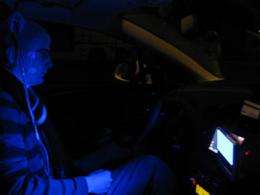Like coffee, blue light keeps night drivers alert

(Medical Xpress)—Researchers from the Université Bordeaux Segalen, France, and their Swedish colleagues have recently demonstrated that constant exposure to blue light is as effective as coffee at improving night drivers' alertness. Based on tests conducted in real driving conditions, the results have been published in the journal PLoS One. They could pave the way for the development of an electronic anti-sleep system to be built into vehicles. Before then, the scientists will be testing this equipment in a broader range of situations.
When driving at night, drowsiness brought about by sleep deprivation reduces a driver's alertness, reflexes and visual perception. Sleepiness is responsible for one third of fatalities on motorways. Apart from taking a nap, which is often impractical, drinking coffee remains the best preventive measure. However, this forces drivers to stop, which they often leave too late. For road safety purposes, it is therefore essential to develop an "embedded" anti-sleepiness device working continuously.
Blue light is known to increase alertness by stimulating retinal ganglion cells: specialized nerve cells present on the retina, a membrane located at the back of the eye. These cells are connected to the areas of the brain controlling alertness. Stimulating these cells with blue light stops the secretion of melatonin, the hormone that reduces alertness at night. The positive effect of blue light on night-time alertness has been known since 2005, notably through American research. But these previous studies only demonstrated this effect during simple cognitive tasks, like pushing a button in response to a light stimulus. Driving is a much more complex task.
To study the efficiency of blue light during night driving, a special LED lamp continuously emitting blue light was installed on the dashboard of an experimental vehicle. The researchers then asked 48 male volunteers (average age 33.2) to drive 400 km on a motorway. Each driver completed three night drives, spaced out by at least a week, between 1 a.m. and 5:15 a.m., with a 15-minute break halfway through the journey. During each of the three nights, the volunteers were either exposed to continuous blue light, or given two cups of coffee (one before departure and one during the break). These either contained 200 mg of caffeine or were decaffeinated, representing a placebo. It is worth noting that drivers' sleep was not affected following the journeys with exposure to blue light. The researchers then analyzed the number of times that a driver encroached on road markings (hard shoulder or centre line), reflecting a decrease in alertness.
The results of this test showed that on average, the line was accidentally crossed 15 times by the drivers exposed to blue light, 13 times by those who had had coffee and 26 times by those who had had the placebo. Continuous exposure to blue light while driving therefore appears to be as efficient as coffee for fighting sleepiness at the wheel, as long as this light does not hinder the driver. In fact, eight of the 48 volunteers (17%) found that they were dazzled by the blue light and therefore could not do the test.
The researchers are now verifying these first results by making a test on a larger number of subjects, including women and the elderly. One of the applications could be the development of an embedded anti-sleepiness device in vehicles.
More information: In-Car Nocturnal Blue Light Exposure Improves Motorway Driving: A Randomized Controlled Trial. Jacques Taillard, Aurore Capelli, Patricia Sagaspe, Anna Anund, Torbjorn Akerstedt, Pierre Philip. PLoS One, 19 October 2012.

















